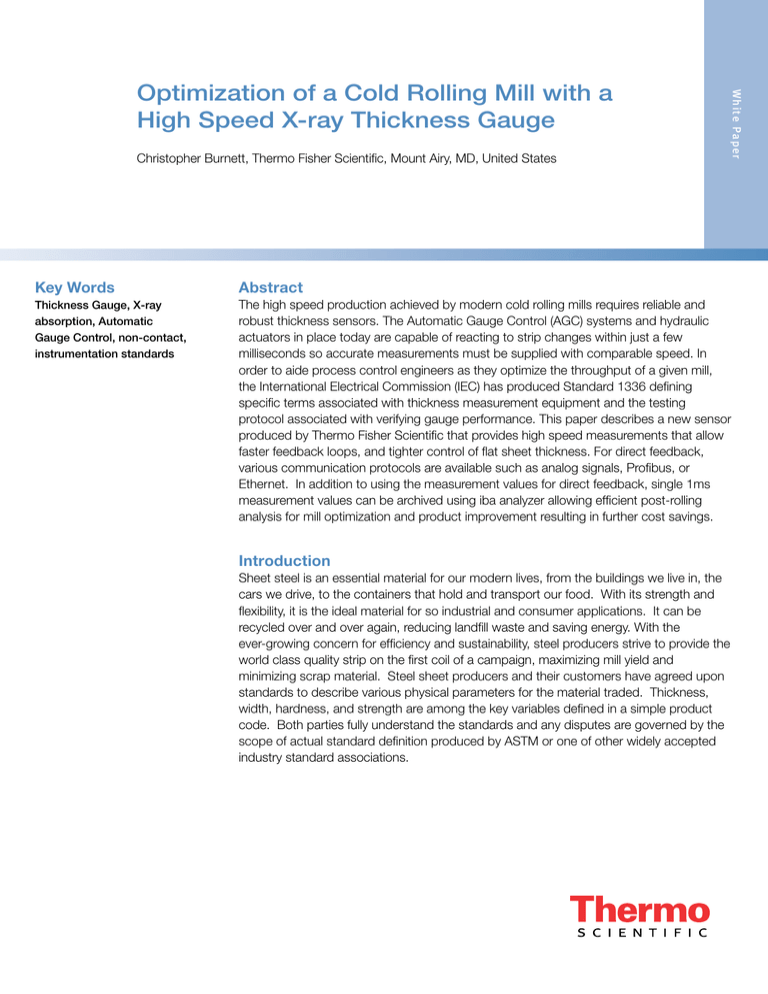
Christopher Burnett, Thermo Fisher Scientific, Mount Airy, MD, United States
Wh i te Pa per
Optimization of a Cold Rolling Mill with a
High Speed X-ray Thickness Gauge
Key Words
Abstract
Thickness Gauge, X-ray
absorption, Automatic
Gauge Control, non-contact,
instrumentation standards
The high speed production achieved by modern cold rolling mills requires reliable and
robust thickness sensors. The Automatic Gauge Control (AGC) systems and hydraulic
actuators in place today are capable of reacting to strip changes within just a few
milliseconds so accurate measurements must be supplied with comparable speed. In
order to aide process control engineers as they optimize the throughput of a given mill,
the International Electrical Commission (IEC) has produced Standard 1336 defining
specific terms associated with thickness measurement equipment and the testing
protocol associated with verifying gauge performance. This paper describes a new sensor
produced by Thermo Fisher Scientific that provides high speed measurements that allow
faster feedback loops, and tighter control of flat sheet thickness. For direct feedback,
various communication protocols are available such as analog signals, Profibus, or
Ethernet. In addition to using the measurement values for direct feedback, single 1ms
measurement values can be archived using iba analyzer allowing efficient post-rolling
analysis for mill optimization and product improvement resulting in further cost savings.
Introduction
Sheet steel is an essential material for our modern lives, from the buildings we live in, the
cars we drive, to the containers that hold and transport our food. With its strength and
flexibility, it is the ideal material for so industrial and consumer applications. It can be
recycled over and over again, reducing landfill waste and saving energy. With the
ever-growing concern for efficiency and sustainability, steel producers strive to provide the
world class quality strip on the first coil of a campaign, maximizing mill yield and
minimizing scrap material. Steel sheet producers and their customers have agreed upon
standards to describe various physical parameters for the material traded. Thickness,
width, hardness, and strength are among the key variables defined in a simple product
code. Both parties fully understand the standards and any disputes are governed by the
scope of actual standard definition produced by ASTM or one of other widely accepted
industry standard associations.
2
Thickness gauge manufactures are also expected to produce and test their equipment in
accordance with an international standard known as IEC 61336. Unfortunately, these
standards are not as well known by thickness gauge users. This can result in confusion
during the gauge selection process, and unmet expectations for new mills and mill
upgrade projects. This paper will review the role of the thickness gauge in a mill, present
an overview of the standards to which all gauging systems should be held and present
how a modern high speed X-ray thickness gauge can be used as a tool to optimize an
cold rolling mill.
Cold Rolling Mills
The evolution of rolling mills has accelerated as the speed of processors and digital
controls have grown by orders of magnitude. The capital cost in a rolling mill is substantial
and investors understand that in order to achieve the maximum ROI and shortest
payback time, the mill needs to produce high quality sheet at the fastest possible mill
speeds. Diligent plant managers are always focused on safely maximizing mill output. To
accomplish this, mills are operated 24 hours a day, 7 days a week. When a mill is down
for any reason, the accountants not only consider the energy and labor consumed while
the mill is idle, but the value of the product that could have been made during that “lost
time.” It is no surprise to hear that mills operate at the highest speeds allowed by their
motors and drives. However, raw production in tons means nothing if the material
produced does not meet quality standards.
Many believe that strip quality begins in the meltshop, and that is not far from the truth.
Controlling the chemistry and thermal history of the steel not only assures the grade
produced will meet the mechanical properties desired of the final product, but that the
strip will handle the tons of pressure and tensions of the high speed rolling process. Table
I summarizes the typical thicknesses and rolling speeds for each mill type. Not
surprisingly, as the material gets thinner, the speeds increase dramatically.
Table I: Overview of Steel Rolling Mill
parameters
Hot Roughing Mill
Hot Finish Mill
Cold Rolling Mill
Maximum
Thickness
> 400 mm
20-50 mm
3-20 mm
Minimum
Thickness
20-50 mm
3-20 mm
0.100 mm
Rolling speeds
(meters per min)
~ 100
~ 1000
~ 2000
Automatic Gauge Control
The average human response time is on the order of a quarter of a second, at the
maximum rolling speed of a cold or foil mill, 8 meters of strip is produced. It is easy to see
why Automatic Gauge Control (AGC) is an essential component of modern rolling mills.
Comprehensive AGC algorithms incorporate readings from dozens of sensors around the
mill.
Some of the key AGC input parameters are speed and tension. (See Figure 1)
Conservation of mass dictates that the mass per unit time entering the mill must equal the
mass per unit time exiting the mill. So as the material is rolled thinner, the speeds must
increase. If the drive motors are off, even by a few centimeters per minute, the strip may
break or cobble with catastrophic results. There is a delicate balance between the
reduction caused by the mill force, and the reduction caused by drawing (extruding) the
material through the gap.
3
For measurement of thin metallic coatings applied to steel strips this X-Ray Fluorescence
(XRF) principle is used: The coated steel strip is exposed to a primary beam of photon
radiation. This photon radiation can be gamma rays or X-rays, having sufficiently high
energy to stimulate excitation and emission (fluorescence) of X-rays. The excitation of iron
atoms in a steel strip leads to emission of fluorescence radiation with an energy of 6.4 keV
(1 kilo electronvolt = 1.6 . 10-16 J).
Figure 1: Selected AGC input variables
for a simple single stand mill
When a mill is operating at 1800mpm, the material moves 3 cm every millisecond. If the
mill is using 0.5 meter diameter rolls, the circumference of the roll would be roughly
equivalent to 50 milliseconds. In order to see any eccentricity or periodic event related to
a roll of this diameter, one would need to have a thickness sensor not only capable of
operating at 5ms, but being able to provide measurements with manageable signal to
noise values.
Thickness Gauge Selection
While there are several choices in thickness gauge technology, there really is only one
choice for the speed and accuracy requirements demanded in optimizing a cold rolling
mill; the X-ray gauge.
Direct contact gauges have the advantage of being insensitive to alloy, the measurement
stylus marks the strip, and the mechanical tolerances of the frame prevent measurement
near the centerline of the strip. Additionally, the small measurement spot size of the stylus
translates microvariations in the strip surface into a noisy signal. While these variations
may actually be in the strip, the signal needs to be filtered to reduce the noise, and the
filtering will delay responses to actual longer term changes. Therefore, high speed AGC is
not practical with contact gauges.
Optical laser gauges that employ triangulation for distance measurements are available,
but they have significant drawbacks in the cold mill. First, they have a relatively narrow
gap between the top and bottom frame arms which can turn this non-contact gauge into
a contact gauge during strip tail out. Additionally, like the contact gauge, the sensor
frame is designed with a short arm length to limit the effect of thermal expansion on the
measurement. This in turn limits the allowable strip width, or restricts the measurement
area to a few centimeters from the edge. Laser gauges can also be sensitive to the high
amount of steam and mist that occurs in a rolling mill. Additionally the laser camera
technology limits the resolution of measurement to a few microns. While this is
acceptable in process line applications, it does not meet the needs of the high-speed cold
rolling mills.
4
Non-contact radiation based thickness gauges can use either radioisotope or X-ray
sources. However in the case where the gauge measurement is to be used in a closed
loop control or Automatic Gauge Control (AGC) system, there is really only one solution,
X-rays. The number of photons emitted from an X-ray source is approximately 1000
times that of the commercially available isotopes. Due to the statistical nature of
radiation detection, measurements made with more photons per unit time have a better
signal to noise ratio, and consequently a more true measurement. In the case of X-ray
versus isotope, the noise level for an isotope is on the order of 20 to 30 times worse
than that of an X-ray based sensor when the same averaging time is used. Statistical
noise at that level creates a situation where small changes in thickness are lost in the
noise of the signal. While higher activity or multiple isotope pellets might be used in an
effort to increase the signal, the regulatory and safety considerations make this option
prohibitive. Another approach to improve the noise on isotope based systems is to
increase the averaging, or response time. However, when this is done, small, and
instantaneous changes in product thickness are blurred to the point of not being seen.
(See Figure. 2)
Figure 2: Simulated sensor responses to
a 250 ms, 1.0% deviation from target
Just as low signal to noise ratio is a serious factor in source selection, one must take
care to select a source of a proper energy as to not have too much signal. While there
may be a small spares inventory savings to use a single source type across a number of
rolling mills, there are serious performance drawbacks. If an X-ray gauge is operated at
too high of an energy, the dynamic range of the detector output is reduced, limiting the
measurement resolution and precision. In the case of thin strip production at around
250 microns, a 10 micron change in thickness results in a signal change of less than
0.2% at a photon energy of 150 keV, whereas the same thickness change at a photon
energy of 40 keV will produce a signal change of over 7% (See Figure 3). When the
statistical noise on the measurement is +/- 0.1%, it is easy to see that the 150 keV
source is just too much for the thin strip application.
5
Figure 3: Sensor response as a function
of steel thickness for different photon
energies
International Standards
International organizations like the ASTM, Japanese Standards Association and others
provide guidance on not only alloy chemistry tolerances, but sheet dimensional
tolerances and mechanical properties as well. For Instrument Suppliers, the
International Electrotechnical Commission (IEC) has produced standards to provide
guidance and definition for specific terms and tests used. The standards act as a
consistent scale to compare one instrument to another without confusing nomenclature
obscuring the true performance of each.
The Nuclear Instrumentation Technical Committee (IEC Technical Committee 45)
produced IEC 61336 “Thickness measurement systems utilizing ionizing radiation –
Definitions and test methods.” The first committee release was in 1983, and an update
was drafted in 1996. The document is available for purchase from the IEC at
http://webstore.iec.ch/webstore/webstore.nsf/ArtNum_PK/21703?OpenDocument , as
such we cannot reproduce it here. The Standard first defines common terms in order to
clarify what specific words mean. For example the “mean response time” may be called
the “first time constant” by some, and something else by others. (See Figure 4) The
fixed definitions avoid any ambiguity in interpretation. They additionally provide guidance
in setting up and carrying out the tests defined in the second part of the standard.
The standard dedicates no less than nine terms to clarify time based parameters. Some
are related to defining the time associated with the time taken to respond to a change,
while others are related to the digital processing of signals. This is particularly critical
with the advent of high speed data processors. Incoming data can be manipulated and
processed by advanced filters to mask or hide true statistical variations. As depicted in
Figure 2 above, radiation measurements are statistical by their very nature. All noise
figures should be quoted with a reference to the number of Sigmas, or confidence levels
(CL). Most gauge manufactures present 2 sigma (95% CL) noise figures, but not all.
Straightforward data processing provides for predictable results and a better
representation of the process dynamics. If a change occurs in the process, advanced
filtering may portray a portion of the change, but not the full change. Process engineers
and their AGC algorithms may over react, or under correct thanks to the manipulated
data.
6
Figure 4: Graphical representation of
gauge response to an instantaneous
thickness change
In order to ethically improve the speed of the sensor response to change, without
increasing the statistical noise on the measurement, the physical characteristics of the
sensor need to be optimized for the application. The raw signal; must be shielded to
remove as much electrical noise as possible. In an ideal instrument, the radiation
detector output is digitized right away. The analog detector signal is converted to a
digital number within a few millimeters of its origin. This practically eliminates the
possibility of electrical noise impinging on the signal. In comparison tests, following the
IEC 61336 guide, the noise on the new designed detector improved by a factor of 30%.
Additionally, users of this type of system can benefit further by taking advantage of the
detector’s ability to operate at a 1ms mean response time. At this speed, and with the
reduced noise, process engineers have the tools to analyze data at high speeds,
revealing mill chatter and other higher frequency anomalies.
In a typical rolling mill that produces sheet steel at 250 um, the noise at a 10 ms mean
response time might be on the order of +/-0.10% (2 sigma). With the improved signal
processing of this system the noise will drop to +/-0.07% (2-sigma). For a mill that
produces 2,000,000 tons a year, that translates to a savings of almost $360,000 in raw
material alone (using HRC price at $600USD per ton).
An additional benefit to digitizing the signal so early in its journey to the AGC system is
speed. Once digitized, the data can be processed with out the time consuming ADC /
DAC conversions. The reduction of a few milliseconds of process delay time can assure
the AGC has time to fully correct any strip thickness deviations. This can result in higher
quality product.
Data Archiving
A final benefit is realized in the powerful tool of data archiving. This ideal system is
available with a software feature that stores any gauge data stream in the iba “.dat”
format. This format is gaining popularity as the iba PDA data analysis tool also grows in
popularity. The flexibility of the iba visualization tool is its real strength. A simple example
of the flexibility is depicted in Figure 5 showing a coil report with the thickness data
presented as a function of length, with tolerances and coil statistics. Easy to use features
allow for time based, and length based data analysis. Built in mathematical tools such
FFT can point process engineers to mill components that might need maintenance. In
this situation, mill downtime can be best managed, and unplanned downtime dramatically
reduced.
7
Figure 5: Typical coil report using iba
data archiving tools
The data archiving feature can also be configured to accept and record data from other
sensors with in the mill. Any data point that is available to the mill computer through an
Ethernet connection can be collected by the system to allow for comprehensive data
analysis. Thus permitting the pairing of thickness measurement output to mill tensions
and speeds in such a way that complies with the IEC 61336 testing standards. The IEC
61336 Annex B defines appropriate test points for data collection and analysis. While
traditional analog outputs are typically used for gauge validation, it is equally acceptable to
use the data transferred via Ethernet, or other means to a data archive.
Summary
Advances in online control of flat sheet have necessitated a state of the art X-ray based
sensor system to provide high speed/low noise measurements permitting producers to
realize material savings and quality improvements. The ideal sensor would be housed in a
robust frame designed for the rigors of the rolling mill environment. The complete
package must be manufactured and tested following IEC 61336 definitions which assure
process engineers receive clear thickness data with out ambiguity. Thus allowing for mill
optimization to achieve world class quality and strip uniformity at the highest rolling
speeds. The result would allow for the maximum return for rolling mill owners and
investors.
Acknowledgement
The author thanks the International Electrotechnical Commission (IEC) for permission to reproduce
Information from its International Standard IEC 61336 ed.1.0 (1996).
IEC 61336 ed.1.0 “Copyright © 1996 IEC Geneva, Switzerland.
www.iec.ch
Thermo Fisher Scientific,
San Jose, CA USA is ISO Certified.
thermoscientific.com
© 2012 Thermo Fisher Scientific Inc. All rights reserved. All trademarks are the property of Thermo Fisher Scientific Inc. and its subsidiaries. Specifications,
terms and pricing are subject to change. Not all products are available in all countries. Please consult your local sales representative for details.
Africa-Other +27 11 570 1840
Australia +61 2 8844 9500
Austria +43 1 333 50 34 0
Belgium +32 53 73 42 41
Canada +1 800 530 8447
China +86 10 8419 3588
Denmark +45 70 23 62 60
Europe-Other +43 1 333 50 34 0
AN12345_E 01/12W
Finland /Norway/Sweden
+46 8 556 468 00
France +33 1 60 92 48 00
Germany +49 6103 408 1014
India +91 22 6742 9434
Italy +39 02 950 591
Japan +81 45 453 9100
Latin America +1 608 276 5659
Middle East +43 1 333 50 34 0
Netherlands +31 76 579 55 55
South Africa +27 11 570 1840
Spain +34 914 845 965
Switzerland +41 61 716 77 00
UK +44 1442 233555
USA +1 800 532 4752
Wh i te Pa per
All such extracts are copyright of IEC, Geneva, Switzerland. All rights reserved. Further information
on the IEC is available from www.iec.ch. IEC has no responsibility for the placement and context in
which the extracts and contents are reproduced by the author, nor is IEC in any way responsible for
the other content or accuracy therein.





